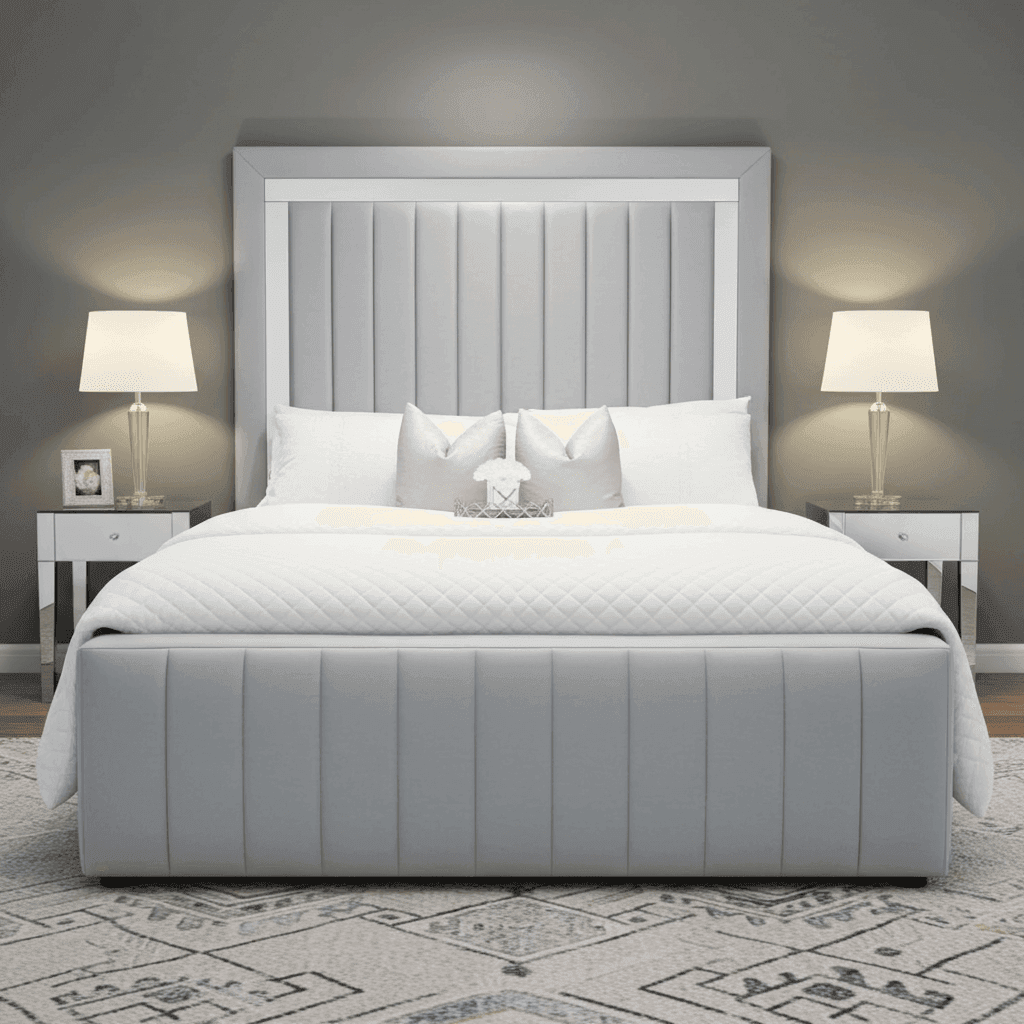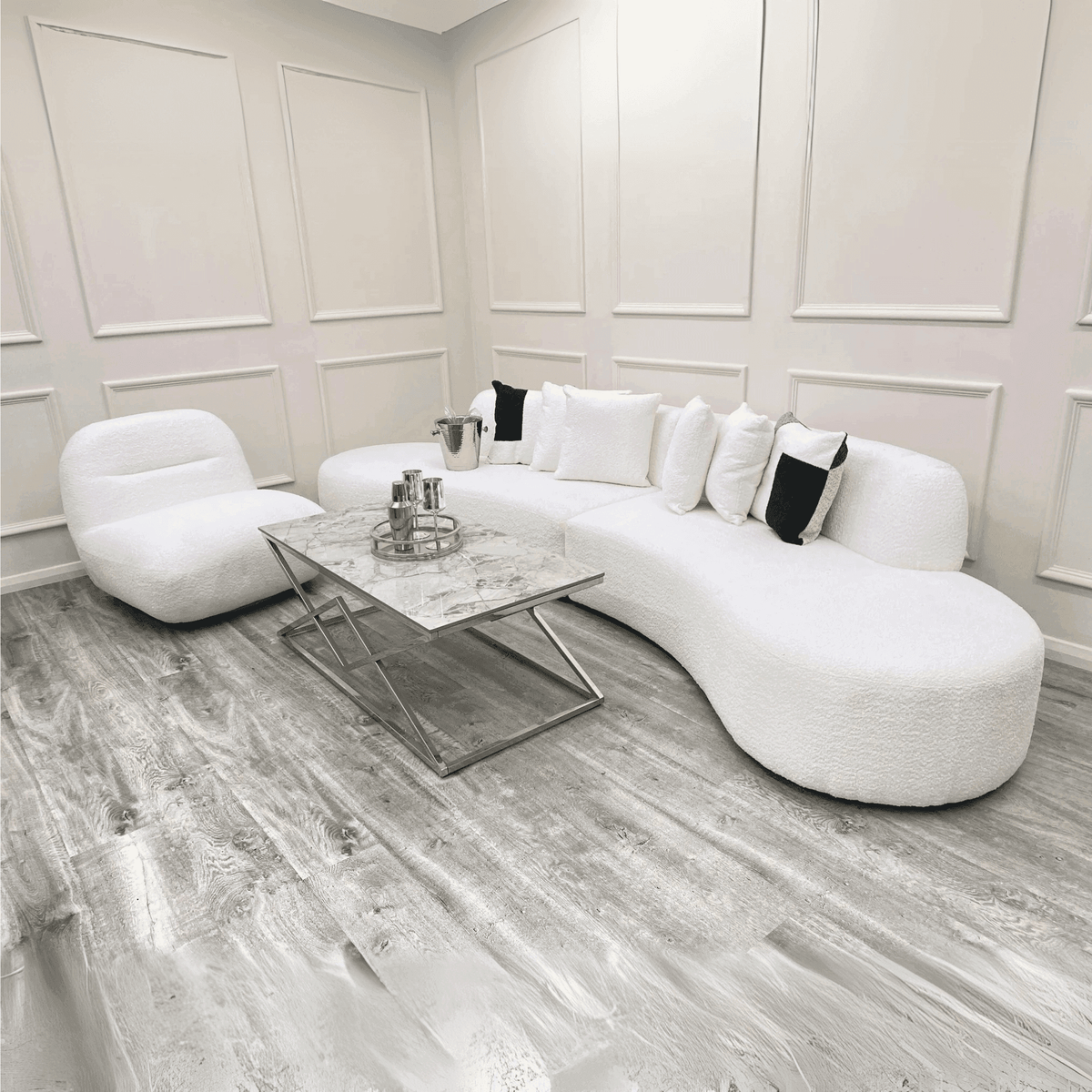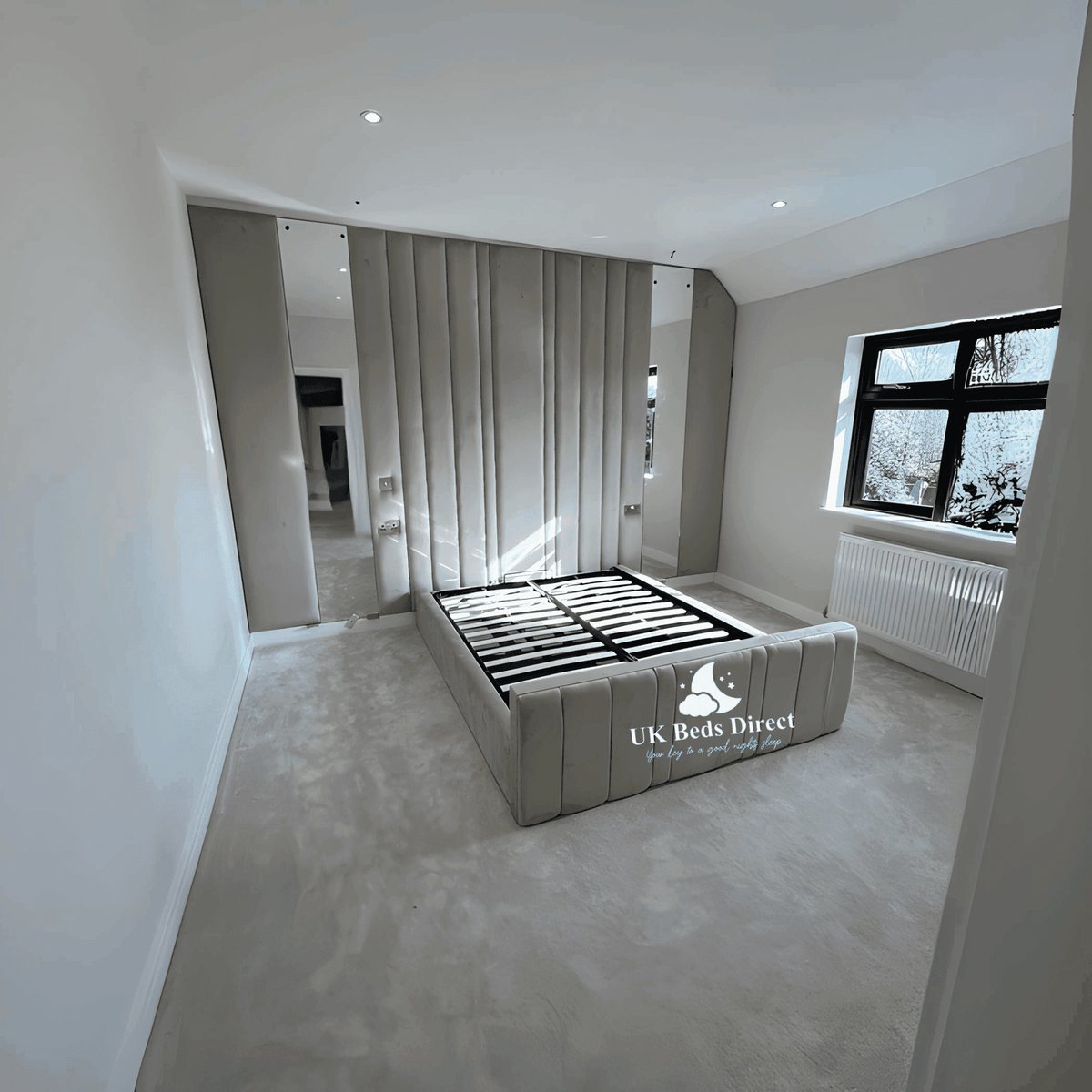- Unlock Dreamland: The Ultimate Guide to Beds with Mattress Bliss
- Introduction to Beds with Mattress Bliss
- What Makes a Bed Dreamy?
- Importance of Choosing the Right Mattress
- The Anatomy of Beds with Mattress Bliss
- The Foundation: Bed Frames and Supports
- The Heart of Comfort: Types of Mattresses
- Factors to Consider When Choosing a Bed and Mattress
- Understanding Different Mattress Types: Foam, Spring, Hybrid
- How to Choose the Right Size for Your Space
- Exploring Ergonomics: Aligning Health and Comfort
- Creating the Ultimate Sleep Environment
- Bedding and Linens: Beyond the Mattress
- Optimizing Bedroom Environment for Maximum Comfort
- Tips and Tricks for Maintaining Your Bed and Mattress
- Extending the Life of Your Mattress
- Simple Maintenance Tips for Lasting Comfort
- Frequently Asked Questions About Beds and Mattresses
- How Often Should You Replace Your Mattress?
- What Is the Best Way to Care for Your Mattress?
- Conclusion: Finding Your Bed with Mattress Bliss
- Summarizing the Journey to Better Sleep
- Encouraging Informed Decisions for Maximum Relaxation
Introduction to Beds with Mattress Bliss
Embarking on the quest for sublime slumber begins with understanding the foundation of exceptional rest: a bed with the perfect mattress. In today's fast-paced world, the sanctuary of sleep has never been more pivotal in maintaining optimal health and well-being. The marriage between an exquisite bed frame and a sumptuous mattress creates the quintessential haven for rejuvenation, a personal retreat where one-third of your life unfolds.
What Makes a Bed Dreamy?
A truly dreamy bed transcends mere functionality; it embodies an amalgamation of aesthetics, engineering, and comfort science. The alchemy of a perfect sleeping arrangement involves several elements working in harmonious concert. First, there's the visual allure—the architectural presence that complements your bedroom's ambiance. Whether you gravitate toward the majestic grandeur of a four-poster bed or the sleek minimalism of a platform design, the visual impression sets the tone for your sleeping experience.
Beyond aesthetics, structural integrity forms the bedrock of exceptional rest. A bed that provides unwavering support without creaking or shifting ensures uninterrupted slumber. The materials employed—be it the rich warmth of mahogany, the rustic charm of reclaimed wood, or the contemporary sleekness of brushed metal—contribute to both the tactile experience and longevity of your investment.
However, the pièce de résistance of any bed is undoubtedly the mattress that crowns it. This essential component transforms a mere piece of furniture into a portal to dreamland, where comfort meets therapeutic support in perfect equilibrium.
Importance of Choosing the Right Mattress
The significance of selecting an appropriate mattress cannot be overstated—it's the fulcrum upon which your sleep quality balances. An ill-suited mattress can precipitate a cascade of undesirable consequences, from chronic back pain and joint discomfort to disrupted sleep cycles and diminished cognitive function.
When you invest in the correct mattress, you're effectively purchasing years of quality sleep. Consider this: a premium mattress tailored to your specific needs can ameliorate existing physical discomforts and preemptively address potential issues before they manifest. The right mattress serves as a silent guardian of your spinal alignment, circulation, and temperature regulation throughout the night.
For the discerning luxury consumer, a mattress represents more than a utilitarian necessity—it epitomizes an investment in holistic well-being. The dividends of this investment pay out nightly in the currency of restorative sleep, enhanced productivity, and elevated mood.
Speaking of exceptional sleep solutions, the Full Memory Foam Mattress from UK Beds Direct exemplifies the pinnacle of mattress engineering for the luxury market. This extraordinary offering combines cutting-edge memory foam technology with meticulous craftsmanship to deliver an unparalleled sleep experience.
The Full Memory Foam Mattress adapts to your body's unique contours, providing personalized support where you need it most. Its temperature-responsive materials ensure optimal comfort regardless of season, while the motion isolation properties mean you'll remain undisturbed even with a restless partner. For those suffering from pressure point discomfort or seeking to elevate their sleep quality to new heights, this mattress offers a transformative solution.
With the foundation of understanding what constitutes a truly exceptional bed and mattress combination, let's delve deeper into the constituent elements that create this essential centerpiece of your sleeping sanctuary.
The Anatomy of Beds with Mattress Bliss
The Foundation: Bed Frames and Supports
The bed frame serves as the architectural foundation upon which your sleep experience is built. Far beyond mere aesthetic appeal, the frame provides crucial structural integrity that influences both mattress performance and longevity. In the luxury sphere, bed frames transcend utilitarian function to become statement pieces that anchor bedroom design while delivering exceptional performance.
Several varieties of bed frames merit consideration for the discerning connoisseur:
- Platform Beds: These sleek, contemporary designs feature a solid or slatted base that eliminates the need for a box spring. Their low profile creates a modern aesthetic while providing superb mattress support.
- Four-Poster and Canopy Frames: The epitome of classical luxury, these frames introduce vertical elements that draw the eye upward, creating a sense of grandeur and enclosure.
- Adjustable Frames: The avant-garde option for customizable comfort, these technological marvels allow position adjustments for reading, alleviating snoring, or addressing circulation issues.
- Storage Beds: Combining practicality with elegance, these frames incorporate discreet storage solutions without compromising on sophistication.
The support system within your frame—be it slats, box spring, or solid platform—dramatically influences mattress performance. Properly spaced slats provide ventilation while preventing sagging, whereas solid platforms offer unwavering support for foam mattresses that require consistent surface tension. The harmony between frame and support system ensures your mattress performs optimally throughout its lifespan.
The Heart of Comfort: Types of Mattresses
At the epicenter of sleep quality lies the mattress—the technological culmination of comfort science and materials engineering. The luxury mattress landscape offers a diverse array of options, each with distinctive properties to suit various preferences:
"The right mattress doesn't merely facilitate sleep; it elevates the very experience of rest to an art form, where comfort and support converge in perfect harmony."
Memory foam mattresses represent the vanguard of personalized comfort, with viscoelastic properties that respond to body heat and pressure, creating a customized impression that cradles pressure points. The sensation is akin to floating, with exceptional motion isolation that ensures undisturbed slumber even with a restless partner.
Latex options offer a more responsive alternative with natural antimicrobial properties. The distinctive buoyancy of latex provides immediate response to movement while maintaining exceptional durability—many premium latex mattresses maintain their integrity for 15+ years.
For traditionalists, innerspring mattresses have evolved significantly from their rudimentary ancestors. Modern luxury versions incorporate individually pocketed coils that respond independently to pressure, minimizing motion transfer while maximizing support. The superior ventilation inherent to this design makes it ideal for those who sleep warm.
Hybrid mattresses represent the apotheosis of mattress engineering, combining the pressure-relieving properties of memory foam or latex top layers with the supportive foundation of innerspring technology. This synthesis delivers multifaceted performance that addresses diverse sleep needs without compromise.
Understanding the interplay between frame and mattress creates the foundation for informed decision-making. Now, let's examine the crucial factors that should guide your selection process for achieving mattress bliss.
Factors to Consider When Choosing a Bed and Mattress
Understanding Different Mattress Types: Foam, Spring, Hybrid
Navigating the mattress landscape requires discernment regarding the intrinsic qualities of each mattress category. Memory foam, renowned for its pressure-alleviating properties, excels in contouring to your body's unique topography. This adaptive material redistributes pressure points, making it particularly beneficial for side sleepers or those with joint sensitivities. However, traditional memory foam can retain heat—a consideration for those who run warm during sleep.
Innerspring mattresses, with their distinctive bounce and responsiveness, facilitate easier movement and position changes throughout the night. The space between coils promotes airflow, creating a naturally cooler sleep environment. Modern luxury iterations employ individually wrapped coils that minimize the transfer of motion while providing targeted support zones for different body regions.
Latex mattresses offer an intriguing middle ground—responsive like innerspring yet contouring similar to memory foam, but without the heat retention concerns. Natural latex options appeal particularly to eco-conscious consumers seeking sustainable luxury, though they typically command premium pricing reflective of their durability and natural composition.
Hybrid mattresses ingeniously combine these technologies, typically featuring comfort layers of memory foam or latex atop a supportive coil system. This configuration aims to deliver the ideal amalgamation of pressure relief, support, responsiveness, and temperature regulation. For those who find single-technology mattresses lacking in certain aspects, hybrids offer a sophisticated compromise.
How to Choose the Right Size for Your Space
Beyond raw dimensions, consider the architectural proportions of your bedroom. A properly scaled bed creates visual harmony within your space. Allow for a minimum of 24 inches of walking space around three sides of the bed for optimal flow and functionality. Remember that oversized headboards or frames with significant footprints may necessitate larger room dimensions than the mattress size alone would suggest.
Exploring Ergonomics: Aligning Health and Comfort
The science of ergonomics—how your body interacts with your sleep environment—forms the nexus between comfort and physiological well-being. Your preferred sleep position substantially influences the optimal firmness level for your mattress. Side sleepers typically benefit from softer surfaces that accommodate shoulder and hip pressure points. Conversely, stomach sleepers require firmer support to prevent spinal misalignment, while back sleepers often find middle-ground firmness ideal.
Consider also your body's unique attributes. Higher body weight generally necessitates firmer support to prevent excessive sinking, while lighter individuals may find firm mattresses uncomfortably resistant. Those with specific health concerns should prioritize relevant features: cooling technologies for hot sleepers, motion isolation for those with restless partners, or adjustable bases for circulation or respiratory issues.
The concept of "comfort" itself varies dramatically between individuals—what feels luxuriously plush to one person may seem insufficiently supportive to another. This subjectivity underscores the importance of testing mattresses whenever possible or selecting options with generous trial periods.
With a comprehensive understanding of mattress types, sizing considerations, and ergonomic factors, we can now explore how to optimize the broader sleep environment for maximum comfort and restfulness.
Creating the Ultimate Sleep Environment
While the bed and mattress form the nucleus of your sleep sanctuary, the peripheral elements collectively orchestrate a comprehensive sleep experience. The cultivation of an optimal sleep environment involves a harmonious interplay of tactile comforts, atmospheric conditions, and sensory considerations that elevate mere rest to transformative rejuvenation.
Bedding and Linens: Beyond the Mattress
The textiles that envelop your mattress constitute the immediate interface between your body and your sleep surface—a critical yet often underappreciated component of sleep quality. Thread count, while frequently emphasized in marketing, represents merely one facet of superior bedding. More illuminating is the fiber composition and weave structure, which determine the fabric's breathability, durability, and tactile pleasure.
Egyptian and Supima cotton varieties, with their extra-long staple fibers, deliver exceptional softness that increases with each laundering cycle. Belgian linen, though initially more textured, offers unparalleled breathability and develops a sumptuous patina over time that many connoisseurs find irreplaceable. For the ultimate in tactile luxury, silk charmeuse sheets regulate temperature while reducing friction on skin and hair, minimizing sleep creases and bedhead.
Beyond sheets, the layering system you employ should accommodate seasonal variations and personal temperature preferences:
- Duvets and Comforters: Consider fill power (the measure of down's insulating ability) and fill weight to achieve your ideal thermal balance. Alternative down options offer comparable performance for those with allergies or ethical concerns.
- Mattress Toppers: These transformative layers can substantially modify your mattress feel without replacement—adding plushness to a firm surface or cooling properties to heat-retentive materials.
- Pillows: Perhaps the most personalized element of bedding, pillows should complement your preferred sleep position. Side sleepers benefit from firmer, higher profiles that maintain neck alignment, while stomach sleepers require minimal loft to prevent spinal distortion.
The tactile harmony of your bedding ensemble should strike a balance between sensory pleasure and functional performance. Premium materials justify their investment through enhanced comfort and superior longevity—quality linens can serve faithfully for decades with proper care, amortizing their cost across thousands of nights.
Optimizing Bedroom Environment for Maximum Comfort
The ambient conditions surrounding your bed significantly influence sleep architecture—the progression through various sleep stages that constitutes restorative rest. Temperature stands paramount among these conditions; research consistently demonstrates that a slightly cool environment (approximately 65-68°F/18-20°C) facilitates the core temperature drop necessary for initiating and maintaining deep sleep phases.
Light management represents another crucial variable in sleep quality. Blackout draperies or shutters eliminate disruptive ambient light, while dawn simulator alarms can later facilitate natural waking by mimicking sunrise. For urban dwellers, soundproofing measures or white noise machines mitigate acoustic disturbances that might otherwise fragment sleep cycles.
Air quality, though less immediately perceptible, profoundly impacts respiratory comfort during sleep. HEPA filtration systems remove allergens and particulates, while maintaining optimal humidity (between 40-60%) prevents both the respiratory irritation of excessively dry air and the potential allergen growth fostered by excessive moisture.
The chromatic palette of your sleep environment should induce psychological calm—research indicates that muted blues, greens, and neutrals promote relaxation by reducing cognitive stimulation. Reserve vibrant hues for accent pieces rather than dominant wall colors or bedding.
Electromagnetic considerations have gained attention in recent sleep research. Creating distance between sleeping areas and electronic devices—particularly those emitting blue light or requiring active wireless connections—may improve both subjective and objective sleep quality measures.
With your sleep environment thoughtfully curated for optimal rest, ensuring the longevity of your investment becomes the next consideration. Proper maintenance extends both the functional lifespan and comfort quotient of your bed and mattress.
Tips and Tricks for Maintaining Your Bed and Mattress
Extending the Life of Your Mattress
A premium mattress represents a significant investment in your wellbeing—one that merits diligent preservation. The foundation of mattress longevity begins with proper support; ensuring your bed frame provides adequate structural integrity prevents premature sagging and deformation. For queen-sized or larger mattresses, a central support bar is indispensable for maintaining proper spinal alignment and mattress integrity.
Rotation—not to be confused with flipping—remains essential even for modern one-sided mattresses. Quarterly rotation (head-to-foot) redistributes wear patterns, preventing body impressions from becoming permanent depressions. Mark your calendar or set digital reminders to maintain this simple yet crucial maintenance schedule.
Protective barriers between you and your mattress offer multi-faceted benefits. A quality mattress protector creates an impermeable barrier against spills, perspiration, allergens, and dust mites without compromising comfort or breathability. For maximum protection, consider encasement protectors that completely surround the mattress, effectively sealing it against potential invaders, particularly important for those with allergies or asthma.
Sunlight, while beneficial for many aspects of health, accelerates the breakdown of mattress materials. Direct exposure degrades foams and fabrics, potentially voiding warranties. When airing your mattress, select indirect light in a well-ventilated space rather than direct sunlight.
The physics of mattress use warrant consideration as well. Concentrated activities like sitting on edges or allowing children to jump compress materials beyond their intended parameters, accelerating deterioration. Distributing body weight as intended—horizontally, across the surface—preserves the structural integrity of internal components.
Simple Maintenance Tips for Lasting Comfort
Regular cleaning transcends mere aesthetics to become a cornerstone of mattress hygiene and performance. Vacuum your mattress quarterly using upholstery attachments and low suction to remove particulate matter that accumulates despite protective covers. This practice removes potential allergens while improving breathability.
Address stains promptly with appropriate techniques based on their composition. Enzymatic cleaners effectively tackle protein-based stains like perspiration or bodily fluids, while mild detergent solutions address most other contaminants. Crucially, avoid excessive moisture, which can penetrate mattress layers and foster microbial growth—use minimal liquid and accelerate drying with fans if necessary.
Box springs or foundation units require parallel maintenance. Inspect regularly for damaged slats, warping, or broken springs that may transfer structural deficiencies to your mattress. Dust and vacuum these components when servicing your mattress to prevent dust accumulation that can permeate upward.
For beds with mechanical components such as adjustable bases, regular inspection of operating mechanisms prevents potential failures. Lubricate moving parts according to manufacturer specifications, typically annually, and examine electrical components for wear or damage.
Bedding maintenance complements mattress care in preserving your sleep environment. Launder sheets weekly in warm water to eliminate oils and skin cells that eventually migrate to your mattress. Pillows should be laundered quarterly (if washable) or professionally cleaned biannually for non-washable varieties. Duvet covers protect their inserts but should themselves be washed monthly, while the inserts may require cleaning one to two times annually.
With proper maintenance establishing the foundation for enduring comfort, let's address some of the most frequently asked questions about beds and mattresses to further illuminate this essential aspect of home life.
Frequently Asked Questions About Beds and Mattresses
How Often Should You Replace Your Mattress?
The replacement interval for mattresses depends significantly on the materials, quality, usage patterns, and maintenance regimen. While the commonly cited eight-year guideline provides a general reference point, numerous factors influence the actual optimal replacement timeline.
Premium luxury mattresses, particularly those constructed with high-density memory foam or natural latex, frequently maintain their structural integrity and comfort characteristics for 10-15 years with proper care. Conversely, lower-density foam products or economy innerspring models may exhibit significant deterioration after just 5-7 years of regular use.
Rather than adhering strictly to chronological guidelines, assess your mattress based on performance indicators. Visible sagging exceeding 1.5 inches, persistent body impressions that don't recover, noticeable changes in comfort or support, increased motion transfer, or unexplained allergy symptoms all signal potential replacement needs. Additionally, significant life changes—such as weight fluctuations exceeding 50 pounds, new medical conditions affecting sleep positions, or the addition of a sleep partner—may necessitate reassessment regardless of mattress age.
The warranty period, while informative, typically addresses manufacturing defects rather than normal wear and comfort degradation. Most premium warranties cover structural failures but exclude the gradual softening or firmness changes that naturally occur through usage.
Consider implementing a transitional approach to replacement—upgrading to a quality mattress topper can extend comfort life by 1-3 years while you research and budget for your next investment. This strategy proves particularly valuable when approaching the end of your current mattress's optimal service life.
What Is the Best Way to Care for Your Mattress?
Comprehensive mattress care integrates preventative measures with responsive maintenance to preserve both comfort and hygienic integrity. Beyond the foundational practices mentioned earlier, several nuanced approaches enhance mattress longevity.
Climate control significantly impacts mattress materials. Maintain bedroom humidity between 40-60% to prevent moisture accumulation within mattress layers while avoiding the material degradation associated with excessively dry environments. Consistent temperature controls prevent the expansion and contraction cycles that stress adhesives and component connections within the mattress structure.
When transporting mattresses between residences, maintain their horizontal orientation whenever possible. Folding or bending, particularly with innerspring or hybrid models, can permanently damage internal structures. If vertical positioning becomes unavoidable during transport, limit this orientation to brief periods and stand the mattress on the side rather than an end to distribute stress more evenly.
The removal of odors requires careful consideration of mattress materials. Baking soda, gently worked into the mattress surface and vacuumed after several hours, neutralizes many odors without introducing moisture or harsh chemicals that might degrade materials. For persistent odors, enzyme-based fabric refreshers specifically formulated for furniture provide effective treatment without saturating inner layers.
Professional deep cleaning merits consideration approximately every two years, particularly for households with allergy sufferers, pets, or in humid climates where dust mite populations flourish. Select services employing low-moisture extraction methods rather than steam cleaning, which can introduce excessive moisture into foam components.
With a comprehensive understanding of mattress selection, environment optimization, and maintenance principles, we can now synthesize these elements into actionable insights for achieving your personal sleep paradise.
Conclusion: Finding Your Bed with Mattress Bliss
Summarizing the Journey to Better Sleep
The pursuit of mattress bliss represents more than a mere furniture acquisition—it constitutes an investment in your physical health, cognitive function, emotional resilience, and overall quality of life. Throughout this exploration, we've illuminated the multifaceted considerations that contribute to exceptional sleep architecture.
We began by examining the foundational elements of beds and mattresses, understanding how frame construction and support systems interact with various mattress technologies to create distinct sleep experiences. The diversity of options—from memory foam's contouring embrace to the responsive support of innerspring systems and the natural resilience of latex—offers solutions tailored to individual preferences and requirements.
Our investigation extended beyond the mattress itself to encompass the holistic sleep environment. The tactile pleasure of premium linens, the atmospheric conditions that facilitate deep sleep, and the maintenance practices that preserve your investment collectively orchestrate an experience that transcends mere rest to become transformative rejuvenation.
The knowledge that approximately one-third of your life unfolds upon your mattress underscores the significance of this decision. Few other purchases exert such consistent influence over your daily wellbeing, making thoughtful selection not merely justified but essential for optimized living.
Encouraging Informed Decisions for Maximum Relaxation
Armed with comprehensive understanding, you're now positioned to make decisions aligned with your unique sleep preferences, physical requirements, aesthetic sensibilities, and investment parameters. Consider approaching your selection process with methodical deliberation rather than impulsive acquisition.
Begin by critically analyzing your current sleep experience—identifying specific elements that enhance or detract from restful slumber. Are you awakening with discomfort? Does temperature regulation disrupt your sleep cycles? Does motion transfer from a partner fragment your rest? These observations provide invaluable guidance for prioritizing features in your next sleep system.
Leverage available testing opportunities but recognize their limitations. Brief showroom trials provide initial impressions but cannot replicate the extended experience of nightly use. Prioritize retailers offering generous trial periods with straightforward return policies, allowing sufficient adaptation time to evaluate true compatibility.
While budget naturally influences selection, consider conceptualizing your mattress as a nightly investment amortized across years of use. A premium mattress costing $3,000 with a 10-year lifespan represents less than $1 per night for potentially transformative sleep quality—a value proposition that contextualizes the initial expenditure.
Remember that personalization defines optimal sleep solutions—what constitutes perfection for one individual may prove wholly unsuitable for another. Trust your subjective experience over prescriptive recommendations, recognizing that your body's feedback provides the most reliable guidance in this deeply personal decision.
The journey to mattress bliss culminates not in acquiring the most expensive or technologically advanced option, but in discovering the precise combination of elements that transports you effortlessly to restorative sleep and returns you to wakefulness refreshed, rejuvenated, and ready to embrace life's opportunities with vigor and clarity.





0 comments